#divinity-deos
Explore tagged Tumblr posts
Text

Today is my hamigo @divinity-deos's birthday!<3
She gets the emperor of her heart for her birthday. :3c Happy birthday Div I love you<3
6 notes
·
View notes
Note
10? :^3c
Hiiiii divinitttyyyy
10. Tell me about an insecurity you over came.
This one is also a tough one, but I think one that I'm trying to overcome is that "not reaponding immediately doesnt mean they're mad at me/hate me". I've unfortunately grown up with people replying to me ASAP so when I message someone and I know theyre online, I'll immediately start to get anxious. I've been working on it though and have definitely gotten better about it!
1 note
·
View note
Note
HAPPY BIRTHDAY ♡ Your stories have brought me many a laugh and cry, thank you for sharing and for caring and just being you!~ 🩷✨️🩷✨️
THANK YOUUUUUU AND THANK YOU FOR SUPPORTING ME AND FOLLOWING MY OCS!!!!!!!!
#i see you divinity-deos#i already read it as divinity-oreos#youve been following for a really long time right???? i always see this name in my notifs#thank you for your consistent support ;w;
11 notes
·
View notes
Text

Queenly Deo, the sender of splendid gifts 🌾
To Demeter Eleusinia. O universal mother, Deo famed, august, the source of wealth, and various named: great nurse, all-bounteous, blessed and divine, who joyest in peace; to nourish corn is thine. Goddess of seed, of fruits abundant, fair, harvest, and threshing are thy constant care. Lovely delightful queen, by all desired, who dwellest in Eleusis' holy vales retired. Nurse of all mortals, who benignant mind first ploughing oxen to the yoke confined; and gave to men what nature's wants require, with plenteous means of bliss, which all desire. In verdure flourishing, in glory bright, assessor of great Bromios bearing light: rejoicing in the reapers' sickles, kind, whose nature lucid, earthly, pure, we find. Prolific, venerable, nurse divine, thy daughter loving, holy Kore . A car with Drakones yoked 'tis thine to guide, and, orgies singing, round thy throne to ride. Only-begotten, much-producing queen, all flowers are thine, and fruits of lovely green. Bright Goddess, come, with summer's rich increase swelling and pregnant, leading smiling peace; come with fair concord and imperial health, and join with these a needful store of wealth. --- The Orphic hymn to Demeter
✿❊✿❊✿❊✿❊✿❊
Portrait of Demeter, I was mainly practicing working with colors and drew from a lot of artistic references for this. Overall, I'm happy with the piece (despite how rough and messy she still looks) , and I had a lot of fun working on this for her
🌾I hope that everyone is doing well, and may Demeter keep your plate full and your cup overflowing 🌾
#demeter#demeter devotee#demeter devotion#demeter worship#hellenic polytheism#helpol#hellenic polythiest#hellenisticism#art#my art#tagamemnon
231 notes
·
View notes
Text




Apocalyptic Seal - 7 Resurrection. Talon Abraxas
Seventh Apocalyptic Seal
Finally, the seventh seal is that of the "Mystery of the Grail", as it was native to the esoteric movement that began in the fourteenth century. On the picture there is a cube representing the space-world, from all sides of the cube springs the world-snake, in so far as it represents the higher forces acting out in the lower; from the mouth of the snake the world-line (as a spiral), the symbol of the purified and purified world-forces; and from this springs the "holy grail", which is opposed by the "dove": all this pointing - and quite appropriately - to the mystery of the creation of the world, of which the earthly is a lower reflection. The deepest mysteries lie in the lines and figures, etc., of this seal.“ (Lit.:GA 34, p. 599)
Seal VII is the reproduction of the "Mystery of the Holy Grail". It is the astral experience which reflects the universal meaning of the development of humanity. The cube represents the "space world", which is not yet permeated by any physical being or physical event. For spiritual science, space is not merely the "void", but it is the carrier which, in a still invisible way, contains within itself the seeds of all that is physical. Out of it, as it were, the whole physical world precipitates, as a salt precipitates out of the still quite transparent solution. And what - in relation to the human being - develops out of the spatial world, undergoes the development from the lower to the higher. Out of the "three dimensions of space", which are expressed in the cube, first grow the lower human forces, illustrated by the two serpents, which again give birth to the purified higher spiritual nature, which is represented in the world spirals. Through the upward growth of these higher forces, man can become the recipient (chalice) for the reception of the pure spiritual world-being, expressed by the dove. Through this, man becomes the master of the spiritual world powers, whose image is the rainbow. This is a very sketchy description of this seal, which contains immeasurable depths that can be revealed to those who allow it to work on them in devotional meditation. This seal is paraphrased with the truth saying of modern spiritual science: "Ex deo nascimur, in Christo morimur, per spiritum sanctum reviviscimus", "Out of God I was born; in Christo I die; through the Holy Spirit I am born again". In this saying the meaning of human development is fully indicated.“ (Lit.:GA 284, p. 94f)
We have seen in a certain way that in the beginning of the evolution of mankind and at the end of it there are the same states of transformation. We have seen these states represented in the man with the flaming feet and the sword protruding from his mouth. In a profound symbolism, the whole being of the world is now revealed to us in the symbol of the Holy Grail. With a few sketchy words I would like to place this seventh seal before your soul.
He who, as an occultist, comes to know our world, knows that space is something quite different for the physical world than mere emptiness. Space is the source from which all beings have, as it were, physically crystallised. Imagine a glass cube-shaped vessel, through which you can see completely, filled with water. And now imagine that certain cooling currents are conducted through this water, so that ice is formed in the most manifold ways. In this way you can get an idea of the creation of the world: the "space"; spoken into the space is the divine word of creation; crystallised out are all things and beings.
This space, into which the divine word of creation is spoken, is represented by the occultist through the water-light cube. Various beings develop within this space. Those closest to us can best be characterised as follows: the cube has three perpendicular directions, three axes, length, height, width - the three dimensions of space are represented by the cube. And now think of the counter-dimensions to these three dimensions as they are outside in the physical world. You can imagine it like this: one person is walking in one direction and another person is coming towards him and the two collide. In a similar way, there is a counter-dimension to each spatial dimension, so that we have six rays in total. These counter-rays represent at the same time the primordial germs of the highest members of the human being. The physical body, crystallised out of space, is the lowest. The spiritual, the highest, is the opposite; it is represented by the counter-dimensions. Here, in development, these counter-dimensions first form themselves into an entity which can best be represented by letting them flow together into the world of passions, desires, instincts. That is what it is at first. Then later it becomes something else. More and more it purifies itself - we have seen to what height - but it has gone out from the lower drives, which are symbolised by the serpent. This process is symbolised by the convergence of the counter-dimensions in two snakes facing each other.
By purifying itself, humanity ascends to what is called the "world spiral". The purified body of the serpent, this world spiral, has a deep meaning. You can get an idea of it from the following example: Modern astronomy is based on two propositions of Copernicus; it has disregarded a third. He said that the sun also moves. The Sun moves forward, in a helical line, so that the Earth moves with the Sun in a complicated curve. The same is true of the moon, which moves around the earth. These movements are far more complicated than is assumed in elementary astronomy. You see here how the spiral has its meaning in the world bodies; and these world bodies represent a figure with which man will one day identify himself. In that time man's power of production will be cleansed, purified; the larynx will then be the organ of procreation. That which man will have developed as a purified serpent's body will then no longer work from below but from above. The transformed larynx in us will become the chalice called the Holy Grail. And just as the one will be purified, so will the other which connects itself with this producing organ: it will be an essence of the world-power, the great world-essence. And this world-spirit in its essence is represented by the image of the dove facing the Holy Grail. Here it is the symbol of the spiritualised fertilisation which will work out of the cosmos when man has one day identified himself with the cosmos. The whole creative aspect of this process is represented by the rainbow: this is the all-embracing seal of the Holy Grail.
The whole gives the sense of the connection between world and human being in a wonderful way, like a summary of the sense of the other seals. This is why the secret of the world is inscribed on the outer edge of the seal. This mystery of the world represents how man is born in the beginning out of the elemental forces of the world. Every human being, when he looks back, has gone through that process in the beginning of time which he is going through spiritually today when he is born anew out of the forces of consciousness. This is what Rosicrucianism expresses [with the letters] E. D. N. : Out of God I am born.
We have seen that within Revelation a second thing is added: death to life. But man, in order to find life again in this death, must overcome this death of the senses in the original source of all living things. And this primal source is the centre of all cosmic development; for we had to find death in order to attain our consciousness. But we shall overcome it when we find the meaning of this death in the Saviour-Mystery. Just as we are born of God, we die in Christo in the sense of esoteric wisdom: I. C. M.
And because wherever something is revealed, there is a duality to which the third must unite, man, when he has overcome death, will identify himself with the spirit (the dove) which pervades the world. He will resurrect and live again in the Spirit: P. S. S. R.
This is the Theosophical Rose Cross. It shines into those times when religion and science will be reconciled.“
(Lit.:GA 284, p. 77) Rudolf Steiner
57 notes
·
View notes
Text
Oh no. The brain worms got me again - not me thinking about yet another plot idea of cancer patient Thomas getting a custom wheelchair.
I fear my friends, she already has a name. Thomas muse and I have a color scheme in mind.
Her name is Gloria as in Gloria in excelsis Deo. Latin for "Glory to God in the highest". A hymn reference.
The frame is Pomegranate Red with gold accents, matching spokes and caster forks.
Thomas is delighted to find he now moves faster than his friends and colleagues.
You will get run over if you don’t move out of his way.
Thomas had taken to giving running commentary as he maneuvered the hallways of the Vatican or zipped down the path in the gardens.
“Clear the way for His Rolling Eminence!” he’d call, cape slightly fluttering, cassock hem tucked strategically.
Vincent eventually has to get him a bike bell so he doesn’t roll over the innocent.
Thomas would snark back they should learn to watch where they’re going.
Liturgical and bespoke, a sleek respectable chariot befitting of supporting His Eminence, Cardinal Grump of the Divine Order of Snark, Apostle to the Bed bound, Exiled to the House of Lawrence. (aka his sister Kath’s apartment across the bridge from St. Peter’s basilica)
Thomas smiled every time he heard her name spoken.
Because for all the damage and grief his body had endured, Gloria wasn’t defeat. She was resurrection and new life on wheels.
Thomas was fast, free and forgiven. “Rolling towards glory.” He would smile.
Functional, stylish, and spiritually endorsed. Long may she roll.
#wheelchair#projecting onto my blorb#seriously I love my wheelchair#my mobility aids have names#disability#the misadventures of cardinal blanket burrito#brain worms#fic thoughts#conclave#conclave 2024#thomas lawrence#ao3 writer#musings
35 notes
·
View notes
Text
The gods of Gaul: Cernunnos
Cernunnos is without a doubt one of the most famous gods of Ancient Gaul, and yet he is actually one of the most mysterious Gallic deities. Sure, he definitively marked the imagination of people - I mean he was literaly used as the basis for the Wiccan Horned God, and you will see lots of Cernunnos-copycats in fantasy RPGs and the like. But... we actually do not know the truth about this god, and despite everybody on the Internet trying to make it sound like we have an easy and simple summary of what he is, we only have strong theories and conflicting hypothesis.
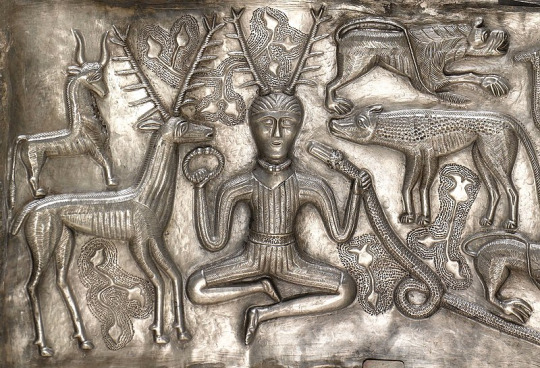
I/ What we actually have
As with a lot of Gallic gods, Cernunnos exists not in legends or myths, but through a name and a visual. The name Cernunnos is found three times all on its own in Gallic documents. One was a Greek inscription from Montagnac that only says "This is dedicated to Karnonos of Alisontia". The other two are identical inscriptions found in Luxemburg (near Steinsel), votive inscriptions of wish-offerings merely saying "Deo Ceruninco". There is actually a fourth inscripton of the name Cernunnos - and it is from this one that we get the spelling we use today - but it is a special one. Unlike the other three, this one has a picture alongside it identifying the god visually. It is the famous "pilier des Nautes" found under Notre-Dame-de-Paris, the "pillar of the Nautes", the "pillar of Boatmen", considered one of the most important Gallic monuments (because it depicts a set of divine portraits with their names explicitely spelled out).
It is only thanks to this pillar that we know today that the many depictions of a male horned god found across Gallic art are meant to be Cernunnos. There are too many visual depictions of him to be listed here (sixty or so were found by archeologists), but among the most famous is the one I put a picture of above: the Cernunnos of the Gundestrup cauldron found in Denmark.
Here is what Cernunnos looks like on the pilier des Nautes:
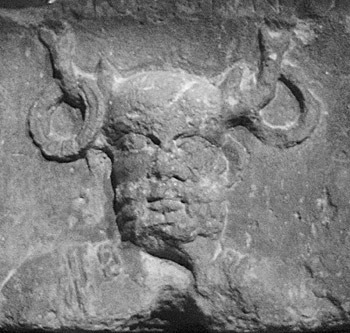
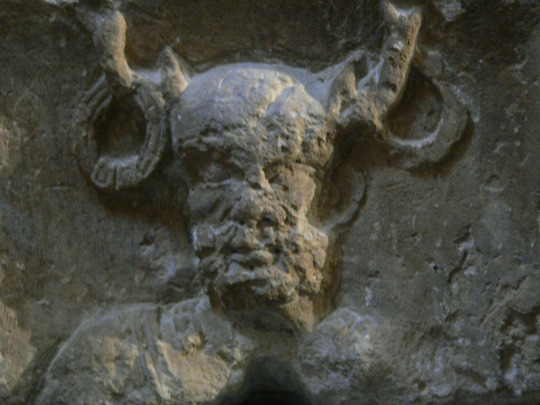

So, we have a name and a bunch of pictures. Let's try to break it all down.
When it comes to the name, Cernunnos/Karnonos, it is commonly agreed by etymologists and those that studied the Gallic language that it means "the horned god". "Carnon/Karnon/Karn" was known to mean "horn", both in the sense of animal's horn and a blowing instrument - it was tied to the Gallic tribes known as the Carni and Carnutes, and to the Celtic carnyx. The "kern" part is also considered to be equivalent to the Old Irish "cern", which was associated with horned beasts. Some have pointed out that if the "Cern" of "Cernunnos" means horn, the "unnos" could be a suffix meaning "beautifully" - so instead of Cernunnos being the "horned god" or the "horned one" it would mean "He who is beautifully horned" or "He with beautiful horns". But all in all, his name stays connected to horns.
[But is it truly his name? This is another debate typical with the gods of Gaul: we do not know the differences between the proper names, the titles and the nicknames. It could be (to take a Greek comparison) like Hestia's case, where he names literaly means "hearth" but is a proper name ; or it could be like the "Old Man of the Sea" which was a generic nickname for a whole group of sea deities.
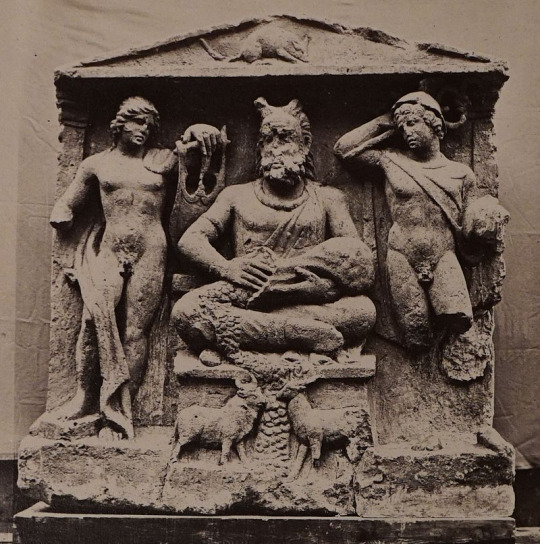
Now let's talk about the images of the god. Thanks to having so many depictions of him, we can identify recurring traits that define his visual.
Cernunnos always appears with his legs crossed, in a position (the "lotus" or "yoga positon" to take Asian terminology) that is considered, depending on the sources, either "very unusual for a god of Gaul", either "absolutely typical of Celtic representations of gods, warriors and heroes"... Well, he is almost always in the "lotus position" - in rare cases, he can be standing up. Cernunnos is also always wearing a torc, the traditional Gallic ornament, though he isn't always wearing it around his neck as one would expect: sometimes he holds it in his hands, other time it hangs from his antlers. Speaking of antlers: as we said, Cernunnos is a horned god, and he is usually depicted with antlers. But sometimes, more rarely, he rather sports goat horns - maybe it is a Romanization effect, as he got confused with Pan?
Cernunnos is always a male figure, though his actual age is unclear. Sometimes he is a mature and bearded man, but we also have "ephebe" depictions of him as a beardless youth - that some researchers even go as far as to describe as "child-like". Similarly, he keeps oscilatting between being a singular entity, and a triple-god with three heads or three faces. The disposition of the three faces can be really weird and freaky - for example, he can have a regular human head, and two small human faces growing from either side of his neck, or from the top of his head.
He usually always has a bag or basket with him, a bag that he eithers opens or that is simply sitting before him, spilling its content: sometimes the bag is filled with food, other times with coins, and other tims yet with grain. Cernunnos is usually sitting in the middle of a trio (as in two other humaoid or divine figures are by his side), or he is surrounded by various animals - which he can be seen holding with one hand, or petting near his lap. There are various animals he is associated with - we have seen him with stags, with bulls, with rats, with dogs, with lions, with goats... He is most notorious for being often depicted with the symbolic-mythical beast of Gaul known as the cryocephal snake: a ram-headed snake, whose exact meaning is still unclear to this day. However, Cernunnos seems to really like them: sometmes they just sit side by side, sometims he holds it by the throat, sometimes he feeds it, and other times two of them sit on his lap.

(This depiction above lacks any horns, but there are two holes at the top of the head implying that the horns were a different part of the statue added separately - which is very interesting in the theory of Cernunnos having antlers that "fall")
One of the problems with the Cernunnos visuals is that it is not clear where they stop, as we got a wide range of variations between the animal and the man. For example, there are strong theories according to which Cernunnos appears on the Strettweg chariot, as the tiny deer with oversized antlers that two men are holding (which would mean Cernunnos could be depicted as a full stag without human traits):
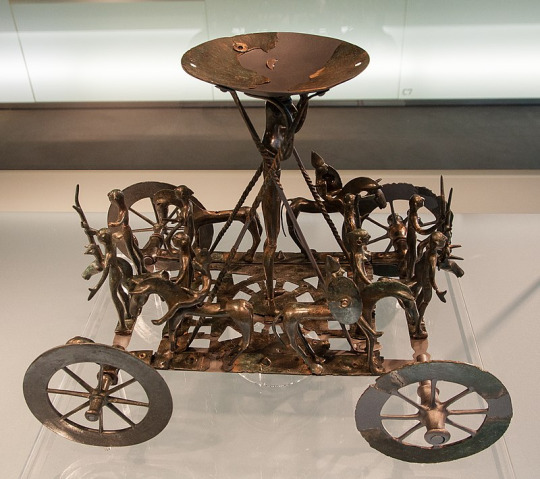
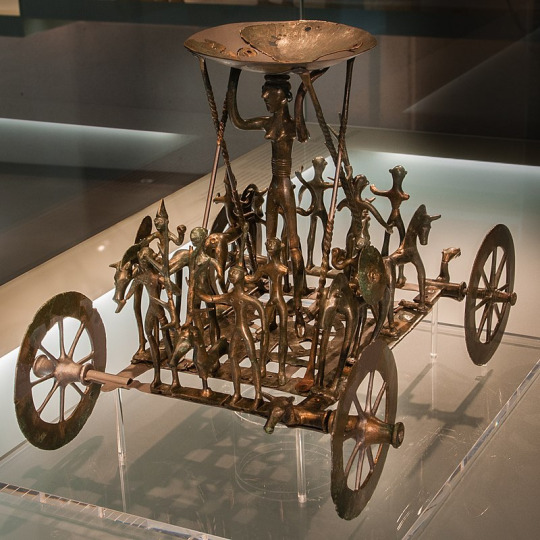
And on the opposite spectrum, a Gallo-Roman statue was found in Amiens of a fully human deity... except for one deer ear on the side of his face. One of the theories to explain this bizarre statue of the first century claims that it is an hyper-Romanized depiction of Cernunnos - though other theories do exist (for example, when the statue was discovered, it was originally believed to depict Midas, with a variation of the "donkey ear" punishment):

And you also have in Bouray a cross-legged god with deer legs rather than antlers or ears:


Given how "late" the visual depictions of the gods of Gaul was, and how the Romanization of Gaul strongly encouraged and favorized the depiction of deities as humanoids (to fit with the Greco-Roman deities), it is very likely that Cernunnos started as a divine stag, as fully animal, and then slowly, especially under the Roman influence, became more and more humanized... (There's also a fascinating case of antlered-goddesses at Clermont-Ferrand and Besançon, but that's for later).
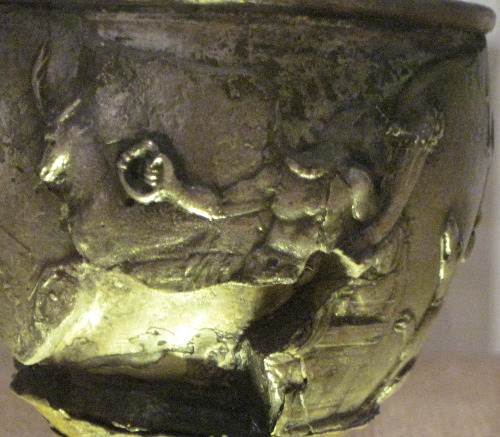
II/ Some theories
Now that we have the name and the visuals done... What's Cernunnos deal? Again remember we can only make theories based on these fragments and their context - but we do not know for certain if it is the truth.
A: It is agreed that Cernunnos is a nature god, and a god of abundance. The fact he is half-stag, and usually depicted with animals, and even holding them in a gesture of domination or use, shows that he is a fauna god, which prompted some researchers to identify him as one of the avatars of the "Lord of Animals, Master of Wild Things" archetype of Indo-European myths. But more importantly we are certain that he dealt with abundance and prosperity - thanks to him always having a big bag of grain, food or money. He was very clearly a god of riches and wealth - be them natural (grain, food) or manufactured (coins). Some have highlighted the idea that this tied to the symbolism of "forests that have big strong stags in them are bound to be fertile places filled with resources". Cernunnos' ties to abundance cannot be denied because in some Classicized depictions of him (such as the silver goblet above), he is literaly seen holding a cornucopia, aka a horn of abundance.
Some people even want to push the domain further by thinking Cernunnos might have been a god of sexual and reproductive fertility - but this is not based on any visual or religious clue. Rather this theory ties on the European symbolism of the stag as a symbol of virility and reproductive prowess, so it is a purely contextual reading, to be handled carefully. We are only truly certain that Cernunnos offered lots of money, lots of grain, lots of food, and lots of animals (him being surrounded by animals might be an extension of the "I offer you this bag of grain" visual, since animals were hunted down for food, so he isn't just a god of good crops and economic riches, but also one that ensures a plentiful hunt).
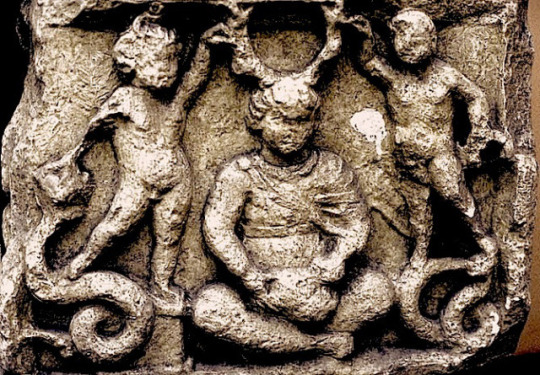
B: There is a strong theory going around that Cernunnos might be a seasonal god, or a deity of the seasonal cycle. This idea comes from various elements pieced together - and which added with the A theory above, would make this go a sort of "Father Nature" figure. It all starts wth the European symbolism of the antlers and the stag in general: given the antlers fall and grow with the turn of the seasons, the stag has been used heavily in Europe as a way to measure the year or symbolize seasons. Some researchers theorized, based on how the size of Cernunnos antlers changes through depictions, and on how he is sometimes a beardless youth sometimes a bearded mature man, that Cernunnos, like the stag, had a seasonal cycle. For some he just loses and grows back his antlers (there is a Cernunnos depiction at Meaux with what seems to be the stubs growing back after antlers fall, which would support this theory), but others push it further by claiming the god died and was reborn each year with winter/spring - an idea inspired by the Indo-European archetype of the dying/sacrifical vegetation god.
There is a specific depiction of Cernunnos that ties into this whole - and I will have to trust Yann Brekilen's word for this, as I couldn't find any picture of the engravings he described. According to him, on the Gallo-Roman Germanicus Arch/Arc, by Saintes, there is a dual depiction of Cernunnos. On one side of the Arch, he is part of a trio: he is sitting crossed-leg with antlers on his head, but naked (usually Cernunnos s clothed in some ways). By his side there is a man armed with a club/mace (which might be tied to the "god with the mace", we'll see that in later posts), and a woman holding a cornucopia. Now, that's on one side of the monument - but on the opposite side, the scene is reproduced... with both the armed man and the antlers of Cernunnos missing, only leaving a regular cross-legged naked man, and the cornucopia-woman. Speaking of this cornucopia-woman: there are repeated talks and interpretations of any female figure by Cernunnos' side to be a "Mother-Goddess" or Earth-Goddess supposed to be the wife/companion/lover of Cernunnos. This is all part of an effort to make Cernunnos a "father-god" (which makes sense in some ways), and it ties into the whole reading of his myth as being a seasonal cycle (the god dying and resurrecting after impregnating his female counterpart ; something the Wiccan mythology for example reused in their beliefs), but... If you ask me, I am not really convinced? A lot of people insist on there being a "Mother Goddess" clearly by Cernunnos' side, but sometimes you see these people reinterpret a lot of the visuals, and it is not obvious that the female figure is with him (Cernunnos is usually surrounded by male figures rather than female ones). Plus, we know the Mother Goddess of Gaul tended to come in three (the famous Matronae) so... I am a bit doubtful of that, but that's just me and because of a lack of convincing evidence.
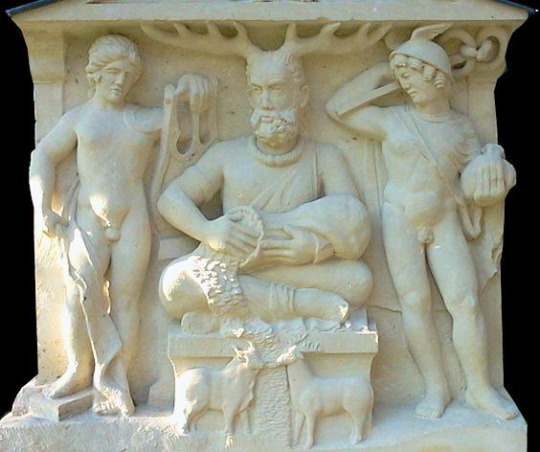
III/ Comparisons and equivalences
As I said in my introduction post, a lot of what we know about the Gallic gods comes from the syncretism the Romans operated with their own deities. And with Cernunnos it is... complicated. Because we do not know exactly who was the Roman equivalent of Cernunnos (since the Romans did not speak of him), and based on researches we have two likely candidates. It is very possible Cernunnos might have been split into those two Roman deities, or at least that his attributes led him to be interpreted as two deities mixed in one.
On one side, there is a very strong and popular theory that Cerunnos was the god Cesar, in his description of the religion of Gaul, called the "Dis Pater". "Dis Pater" was the Latin god that was equated and synthesized with the Greek Hades under the share nickname "Pluto", "the rich one". This was because Dis Pater was not originally a god of the dead in the old Italian religion - he was an underground god, indeed, but a chthonic god of riches and wealth, an earth-god of fertility (his very name meant "Rich Father"). This is what tied him to Hades, the richest of the Greek gods - and made him the new god of the underworld and the dead, Pluto. So, equating Dis Pater with Cernunnos makes sense as we do know that both deities were strongly associated with an earthly form of fertility: Cernunnos, just like Dis Pater, brought grain and earth-grown fruit, as well as precious metal (in the form of coins). Not only that, but Cernunnos was strongly associated with the ram-headed snake, and while we don't know much about this mythical being (typically a companion of male gods in Gallic art), it seems to have been a chthonian symbol, and perhaps even a form of guardian of the world of the dead (or a guardian of underground riches cousin of the dragons of legends). This is what led many to interpret Cernunnos as a chthonian deity, perhaps even an afterlife deity - a tradition that seems to have been in early Christian art, where Cernunnos was often associated with the "mouth of Hell" or the "entrance to Hades" (like the 9th century manuscript Stuttsgart Psalter, which illustrates Cernunnos in a depiction of the Christ descending into Limbo.
If Cernunnos is indeed Cesar's Dis Pater, then it would be extremely interesting, because Cesar wrote in his records that the peopleof Gaul believed Dis Pater to be their divine ancestor, and the "father of their race". Aka, the Gallic Dis Pater is meant to be an All-Father, the first ancestor of the Gallic tribes, and the origin of the human race (or at least of the people of Gaul). If Cernunnos is this Dis Pater, it would confirm his role as a "Father-God" and his links to a potential "Mother-Goddess". (It could also explain why he so persistantly wears a torc, as an emblem of the civilization and traditions of Gaul) If Cernunnos is also the Dis Pater, it would give him a role as a nocturnal god, since Cesar resumed in his texts (or rather "recaped" since he was doing a report based on Posidonius own records) that it was because the people of Gaul descended from Dis Pater that the druids measured the time not in "days" but in "nights"...
The other very likely candidate for the Romanized Cernunnos is the one we call the "Gallic Mercury". We know that Mercury was one of the most popular and widespread gods of Gallo-Roman gaul. Cesar did mention him as one of the most important gods venerated by the Gallic tribes before the omans arrive (though this would contadict the is Pater theory, since Cesar identifies Dis Pater and Mercury as two different deities in the Gallic beliefs). Still, Mercury was a god of commerce and riches before all - even more so than his Greek counterpart Hermes - so it makes sense that he would be present in the Gaul province of the Empire, which was big heart of commerce. And where Mercury has a pouch of coins, Cernunnos has a full bag of them... And in several Gallo-Romans depictions one of the two gods that surround Cernunnos is very obviously Mercury... [Several of the images in this post are of the altar of Reims, which depicts Cernunnos surrounded by Apollo on one side and Mercury on the other] And Cernunnos' presence on the Pillar of Boatmen implies he was tied to the fluvial sailors, and to the fluvial commerce and travels... And in Luxembourg we have Gallic depictions of stags vomitting coins, again insisting on how the stag was associated with riches... Even if you take Cernunnos as a chtonian god or death god, it ties to Mercury's role as a psychopomp inherited from Hermes ; and Mercury's presence by Cernunnos side on the altar of Reims for example makes sense if you consider one of the deities Cernunnos was conflated with was Pan (hence the goat horns) - aka, the son of Hermes... Everything is tied together into one big convoluted web of inter-mythologies.

And when it comes to comparisons to other Celtic mythologies, things are a bit... In French we say "vaseux" - basically there were parallels drawn between Cernunnos and Celtic figures of the Isles, but they rely on very meager if not unstable links. For example some have tried to identify the Cernunnos of Gaul with the Irish figure of Nemed (interpreted as a "stag-god" leading "stag-people" or "deer-people"), and in return the battle between Nemed and Balor for the land of Ireland was projected onto the scene depicted on the Arch that I described prior - a battle between the horned god and the god with the mace for the "earth-mother", the cornucopia woman, the land-goddess. The acceptance of this scene between the horned god and the mace god as a battle for the mother-goddess (which, I insist, was not PROVEN in any way and is completely hypothetic and theorized with no definitive proof - maybe the mace god is here to sacrifice the horned god for the cornucopia-woman, or maybe he is just here to cut off his antlers, or maybe the cornucopia woma cheats on Cernunnos wit the mace god, we cannot know), also led to vague comparisons being drawn to the story of Pwyll and Arawn and how they exchange each other's identities, but we are really in a stretch here.
More interestingly there is a Welsh comparison that could indicate a leftover of a Christianized Cernunnos in an Arthurian setting: the Owein tale (Mabinogi): Kynon, a knight of King Arthur's court, describes how in his youth he had to encounter an ugly knight clad in a black armor who had the information he needed to find his enemy. The knight lived by a "fountain" (a water stream) surrounded by wild and ferocious animals - and to give Kynon the information he needed, the ugly black knight struck a stag nearby, and the animal lowers its head in the direction Kynon must follow. It is very plausible that this supernatural knight who hits an informative stag and who lives surrounded by wild animals is a form of Christian censorship or caricature of a Cernunnos figure, going from a wise and benevolent stag-god to an ugly evil knight who abuses animals, and who has his duality human/beast split between the knight and the stag.
There were also tenuous elements that made people consider the Irish Conall Cernach (known for being one of the sidekicks of Cuchulainn) as a diluted version of Cernunnos as a "Master of Beasts" - more precisely an episode in "The Cattle Raid on Fraech" where instead of killing a monstrous snake, Conall somehow tames it and wears it as a belt, has been compared to Cernunnos' handling of snakes and ram-headed snakes. And don't even get me started on the many, MANY saints of Catholicism that are supposed to be leftovers or reinventions of Cernunnos (saint Ciaran of Saighir, because he tamed wild beasts including a stag ; or the saints of Bretagne Edern and Théleau both supposed to ride a stag instead of a horse...).
The complicated thing (well ONE of the complicated things) with Cernunnos is that he is tied to the stag, and the stag was one of the most prominent smbols and images of the medieval and proto-medieval imagery in Western Europe. You had lot of old mythology stuff that survived in modern days, but you also had lots of medieval symbolism and images (like how the flying stag was one of the symbols of the king of France), and a HUGE re-use of the stag by Christianity in various forms (from the antlers falling being used as a symbol of the Resurrection, to the hunt for the white otherwordly stag of Celtic myths suddenly becoming a hunt for Christ incarnate when a glowing cross appears above the stag's head...). As such it is hard to pin-point what the Gauls truly believed the stag meant, versus the stag symbolism that arose in the Middle-Ages.
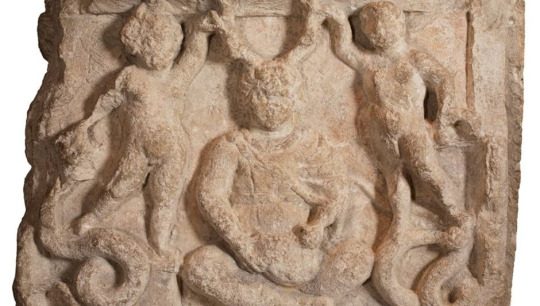
To conclude this post, while I said I had my doubts with systematic identifications of Cernunnos as a companion of a Mother-Goddess, I want to briefly return about a fascinating trivia of Gallic researches: the existence of a female version of Cernunnos, a "Cernunna" we could jokingly say.
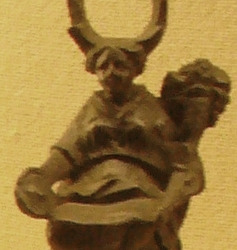
Little figurines and statues were found of a horned goddess - sometimes with antlers! - in both the area of Clermont-Ferrand (which was the domain of the Avernes folk) and around Besançon (the Séquane folk). Who were these goddesses? Local variations of Cernunnos? Sisters, daughters or wives of the god? Or completely unrelated deities? Were they one or several (some are more matronly, motherly figures such as the one with antlers above, others have Venus-like poses unveiling their breast and legs such as the bull-horned below)?
We will probably never know - but while they can be incarnations of this famed "Mother-Goddess" companion of Cernunnos everybody speaks about (and links to the importation of the cults of Demeter and Cybele in Gaul), it is VERY likely these statues date from the Gallo-Roman era and from a Romanized version of the Gallic religion. Indeed, they are all tied by their attributes - they hold a cornucopia, and a "patère" (sacred vase for religious libations). Attributes present in very Romanized Gallic goddesses (such as Rosmerta), but also in typical Roman deities (mainly the lares). Add to that how the adjunction of a male attribute (the stag antlers or bull horns) to a female figure is VERY unusual for Gallic depictions (where the genders are neatly split), while the divine androgyny was a feature of Greco-Roman mythology (the effeminate Apollo and Dionysos, the masculine goddesses Athena and Artemis, the mythical Hermaphrodite...), and it is very likely these statues of the "Cernunna" are the result of the Roman religion "breeding" with the Gallic beliefs...
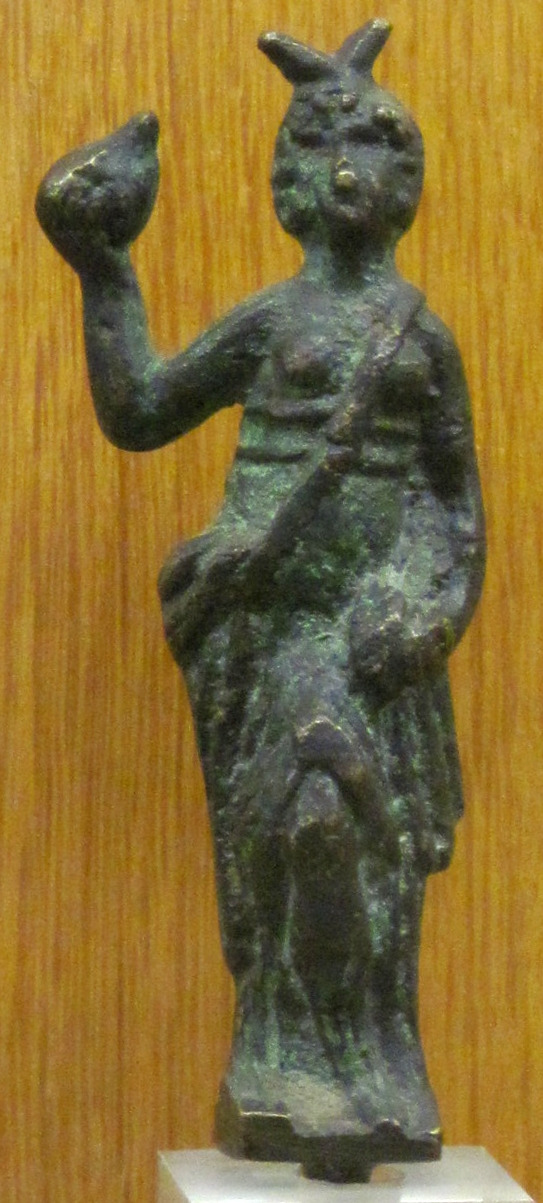
#gods of gaul#gallic mythology#cernunnos#ancient gaul#religion of gaul#gallic religion#gallic gods#gallic goddesses
326 notes
·
View notes
Note
What would you say is the earliest church heresy? Like, the original big no-no
Oh see now you've hit an interesting little rabbit hole without realizing it, because we know both a whole lot and also not much about the early days of the Christian church as we understand it.
So this faith leader guy gets executed or whatever, right? And now you have a bunch of his post-postmortem followers running around spreading his branch of weird Judaism which gets twisted into the first beginnings of Messianic Christianity. But this is back in ye olde days, and also the Romans are gonna be killing any Christians they can find, so the earliest days of the church are mystery cults sporadically popping up like mushrooms. (Is the Holy Spirit like a mycelial network? Who can say)
One of these early Christians was a very popular guy named Arius. Arius told his followers that Jesus WAS born of God, but that he was NOT God himself (the word you're looking for vis a vis that relationship is that Jesus is consubstantial with God, as in, made of the same simultaneous divinity.) and therefore should not be worshipped as one would God.
Then some time passes and all the big bishops of this hot new gig called Christianity realize, wait, hold on, we need to get shit straightened out. We can't ALL be calling ourselves Christian when people are saying Jesus was a hologram, or that he was born of God but isnt God, or that he was just some guy that God really liked. We need to all sit down and decide what we as a unified and universal group believe about our religion. So they all go down to this little place called Nicaea where everyone hashes out exactly what they believe in as Christians, and the end result is that Arius was shot down, which is why in the Nicene Creed there's that one specific line that goes something like this:
Et in unum Dominum Iesum Christum, Filium Dei unigenitum, ex Patre natum ante omnia saecula. Deum de Deo, Lumen de Lumine, Deum verum de Deo vero, genitum non factum, consubstantialem Patri; per quem omnia facta sunt.
Sharp eyes may have spotted that special little word consubstantialem in there. The earliest founders of the early church basically made certain that in their formalized dogma, Arianism would always be called heretical, because Jesus' position in the trinity requires him to be equal to but distinct from the Father. All of trinitarian Christianity agrees that Arianism is a no go.
Personally I do think we should have more Judasian heresies though. Like I guess I get why so many early heresies are centered around the nature of the trinity and specifically J Dog but it does begin to grate.
#this is all to say btw that functionally there are several contenders for earliest heres#y. because before the nicene creed everyone was doing heresy technically#but arianism is the big name on the block#the other 3 big ones are nestorian eutychian and apollinarian heresies#collectively theyre like the avatar nations of heresy. the four great early heresies etc
120 notes
·
View notes
Text
They cannot relate either who made this wooden image or how it caught fire. But the old image was destroyed, and the Phigalians gave the goddess no fresh image, while they neglected for the most part her festivals and sacrifices, until the barrenness fell on the land. Then they went as suppliants to the Pythian priestess and received this response:—“Azanian Arcadians, acorn-eaters, who dwell In Phigaleia, the cave that hid Deo, who bare a horse, You have come to learn a cure for grievous famine, Who alone have twice been nomads, alone have twice lived on wild fruits. It was Deo who made you cease from pasturing, Deo who made you pasture again After being binders of corn and eaters of cakes, Because she was deprived of privileges and ancient honors given by men of former times. And soon will she make you eat each other and feed on your children, Unless you appease her anger with libations offered by all your people, And adorn with divine honors the nook of the cave.” - Pausanias, Description of Greece 8.42.5-6
16 notes
·
View notes
Text

Today is @divinity-deos birthday! And they deserve some Kara goodness for today<3
Happy birthday<3 He loves you so very much<333 Now get in there and bury yourself in his chest<333
11 notes
·
View notes
Note
I didn't expect the quiz to call you out too I'm sorry LMAO
NOOOO ITS OKAY I WAS JOKING AHAHAH DHXYSGS
You 🤝 Me
Getting called out via a Uquiz
1 note
·
View note
Text

Zeus Greek god, deep dive
Zeus is the Greek god of weather and many things, He is a kind a merciful God, as long as you don't speak unwell or lie. he is a god, and I may add, the king of the gods.
Herbs • Holm oak, olive tree, star anise, dandelion, almonds, pine, vervain, oak in general.
Animals• cuckoo-bird, swan, bull, satyr, eagle, wolf, woodpecker, ants
Zodiac • Sagittarius and Pisces, maybe cancer.
Colors • Silver, blue, white, gold
Crystal• White and yellow diamonds, Lapis lazuli, Blue and yellow sapphires, turquoise, celestite, iron/steel, any quartz
Symbols• olive tree branch, throne, Lightning bolt, a crown, scepter, the Aegis
Diety of• sky and weather, the Greek gods, cities, the home, property, strangers, guests, and supplicants, law, order, justice, hospitality, Kings
Patron of• the sky and weather, men, the Greek gods, cities, the home, property, strangers, guests, and supplicants, law, order, justice
Offerings• Wine, Whiskey, Milk, Tea, Coffee, Small cakes, Breads, Red meat, Scaled fish, Fruit, Rain water, Silver, blue, white, gold candles, Figures of eagles and bulls, Symbols of a thubderbolt, The scales of justice, Crowns, Statues of Himself, eagles, or thunderbolts, Cinnamon, Laurel, Art or pictures of eagles and bulls, Eagle and bull plushies/toys, Oak, Pine, Toy crowns, Imagery of thunderbolts (ex- art, keychains, pictures, toys), Photographs or art of storms, Golden oobjects, Blue, white, or gold flowers, Assignments you got good grades on anything you are proud of (ex-art, writings, a dance you made or perfected, your songs, your favorite toy that you’ve taken care of for years.), the fat on the bones of the animals, a scepter, throne photos &, etc, fruit juice, rainwater, wedding rings, White wine, medals, hammers, acorns, cotton balls, coins.
Devotional• Check the weather for the day, Learn to recognize the different kinds of clouds, Speak out if you see an injustice (do not speak over those actually receiving the injustice), Dance in the rain, Examine ideas on fatherhood, examine how any paternal influence you received may have impacted your life, your parents for the good parenting you received, Listen to storms and bask in their glory (whether its a real storm or you’re just listening to a recording of one), Learn to appreciate different kinds of weather, learn the property lines of your house, Take care of yourself, Learn a little more about politics and the current political state of your country, fight for what you believe in (only if it is not harming others), Help sort out a conflict or an argument, Also learn about your country’s legal system, Be hospitable, Take leadership in a project that you’re doing, Destigmatize sex work and homelessness, Practice divination, Learn about your local hawks/eagles/birds of prey, learn ornithomancy (divination from the flight of birds), study meteorology and climate change, study local and national politics, practice good citizenship, vote, volunteer to register voters, support issues and candidates, collect rainwater, support your family, help your grandparents, help people move, donate to charity & homeless centers, worship his family in his honor, singing his praises (he likes being complimented)
Ephithets• ABRETTE′NUS/Abrettênos-surname of Zeus in Mysia, ACRAEUS/Akraios-given to various goddesses and gods whose temples were situated upon hills, AEGIDU′CHOS/AEGI′OCHOS/Aigidouchos/Aigiochos- surname of Zeus, as the bearer of the Aegis when he strikes terror into the impious and his enemies, but also a surname of Zeus being fed by a goat, AENE′IUS/AENE′SIUS/Ainêios/Ainêsios- surname of Zeus when he was worshipped in the island of Cephalenia, AE′THIOPS/Aithiops-the Glowing or the Black, AETNAEUS/Aitnaios -an epithet given to several devine beings connected with Mount Aetna, AGAMEMNON/Agamemnôn- A surname of Zeus, under when he was worshipped at Sparta, AGATHODAEMON/Agathodaimôn/Agathos Deos-Good God, when Greeks drank a cup of unmixed wine at the end of every repast, AGE′TOR/Agêtôr- surname given to several gods, AGO′NIUS/Agônios- a surname or epithet of several gods used in the sense of helpers in struggles and contests, AGORAEUS/AGORAEA/Agoraia/Agoraios-epithets given to several divinities who were considered as the protectors of the people in agora, ALASTOR/Alastôr- surname of Zeus, describing him as the avenger of evil deeds, ALEXI′CACUS/Alexikakos- the averter of evil, AMBU′LIU/AMBU′LIA/AMBU′LII/Amboulia/Amboulioi/Amboulios- surnames when the Spartans worshipped Athena, the Dioscuri, and Zeus, APE′MIUS/Apêmios- a surname of Zeus when he had an altar on mount Parnes in Attica where sacrifices were offered to him, APESA′NTIUS/Apesantios- when zeus had a temple on mount Apesas near Nemea, where Perseus was said to have first offered sacrifices to him, APOMYIUS/Apomuios- driving away the flies, AREIUS/Areios- either the warlike or the propitiating and atoning god, ASBAMAEUS/Asbamaios- protector of the sanctity of oaths, A′SIUS/Asios- surname of Zeus, from the town of Asos or Oasos in Crete, ATABY′RIUS/Ataburios- surname of Zeus derived from mount Atabyris or Atabyrion in the island of Rhodes, ATHO′US/Athôos - a surname of Zeus, derived from mount Athos, CA′RIUS/Karios-where he had a temple at Mylassa in Caria, CA′SIUS/Kasios-surname of Zeus, derived from amount Casion not far from Pelusium, CATAE′BATES/Kataibatês-who descends in thunder and lightning, CATHA′RSIUS/Katharsios- the purifyer or atoner, CENAEUS/Kênaios- derived from cape Cenaeum in Euboea, CHRYSAOR/Chrusaôr- The god with the golden sword or arms, CLA′RIUS/Klarios- the god who distributes things by lot, CO′NIUS/Konios- the god who excites or makes dust, CORYPHAEUS/CORYPHAEA/Koruphaia -the highest or supreme god, and is, CROCE′ATAS/Krokeatas- derived from Croceae, near Gythium in Laconia, CRO′NIDES/CRONI′ON/Kronidês/Kroniôn- a patronymic from Cronus, and very commonly given to Zeus, the son of Cronus, CTE′SIUS/Ktêsios - the protector of property, DICTAEUS/Diktaios- derived from mount Dicte in the eastern part of Crete, ELEUTHEREUS/Eleuthereus- used in the sense of the deliverer, and occurs also as the surname of Zeus, EVA′NEMUS/Euanemos- the giver of favourable wind,
GAME′LII/Gamêlioi theoi- divinities protecting and presiding over marriage, GENETAEUS/Genêtaios- derived from Cape Genetus on the Euxine, HETAEREIUS/Hetaireios - the protector of companies or associations of friends, HOMAGY′RIUS/Homagurios- god of the assembly or league, HO′RCIUS/Horkios- the god who watches over oaths, or is invoked in oaths, and punishes their violation, HYES/Huês- the moist or fertilising god, HYE′TIUS/HYES/HY′PATUS/Hupatos-the most high, ITHOMATAS/Ithômatas- derived from the Messenian hill of Ithome, LABRANDEUS/Labrandeus derived from a temple he had at Labranda, LAPE′RSIUS/Lapersios- derived from the Attic demus of Lapersae, LAPHY′STIUS/Laphustios- derived either from Mount Laphystius in Boeotia, or from the verb laphussein, to flee, in reference to the human sacrifices which were offered to him in early time, LARISSAEUS/Larissaios- derived from the arx Larissa at Argos, LECHEA′TES/Lecheatês- the protector of childbed, LEUCAEUS/Leukaios- when he was worshipped at Lepreus, in Elis, LIMENO′SCOPUS/LIME′NIA/LIMENI′TES:LIMENI′TIS/Limenia, Limenitês/Limenitis, Limenodkopos- the protector or superintendent of the harbour, LYCAEUS/Lukaios- a surname of certain divinities worshipped on mount Lycaeum in Arcadia, MAEMACTES/Maimaktês- the stormy, MECHANEUS/Mêchaneus- skilled in inventing, MEILI′CHIUS/Meilichios-the god that can be propitiated, or the gracious, MESSAPEUS/Messapeus- derived when he had a sanctuary between Amyclae and mount Taygetusm, MO′RIUS/Morios- the protector of the sacred olive trees, NEMEIUS/Nemeios- when he had a sanctuary at Argos, with a bronze statue, the work of Lysippus, and where games were celebrated in his honour, NOMOS/Nomos-a personification of law, OGO′A/Ogôa- the Carian name of Zeus at Mysala, when he had a temple where a sea-wave was seen from time to time, OLY′MPIUS/Olumpios- the Olympian, occurs as a surname of Zeus and in general of all the gods that were believed to live in Olympus, O′MBRIUS/Ombrios- the rain-giver, PANHELLE′NIUS/Panellênios- the god common to, or worshipped by all the Hellenes or Greeks,, PARNE′THIUS/Parnêthios- derived from Mount Parnes in Attica, PATROUS/PATROA/Patrôios/Patrôia- all the gods whose worship has been handed down in a nation or a family from the time of their fathers, whence in some instances they are the spirits of departed ancestors themselves, PHY′XIUS/Phuzios ex- the god who protects fugitives, PI′STIUS/Pistios- the god of faith and fidelity, POLIEUS/Polieus- the protector of the city, SOTER/Sôtêr- the Saviour, STHE′NIUS/Sthenios- the powerful & the strengthening, XENIUS/XE′NIA/Xenia- masculine Xenios are epithets of Athena and Zeus, as presiding over the laws of hospitality, and protecting strangers,
ZYGIUS/ZYGIA/Zugia/Zugios- surnames of Hera and Zeus, and as them as presiding over marriage, Ομβριος/Ombrios- Of the Rain, Ὑετιος/Hyetios- Of the Rain, Αφεσιος/Aphesios- Releasing (Rain), Σκοτιτας/Skotitas- Dark, Murky, Κεραυνιος/Keraunios-Of the Thunderbolt,!Αστραπαιος/Astrapaios-Of the Lightning, Καταιβατης/Kataibatês-Descending, Λαβρανδευ��/Labrandeus-Furious, Raging, Ικμαιος/Ikmaios-Of Moisture, Κονιος/Konios-Of the Dust, Μαιμακτης/Maimaktês-Boisterous, Ευηνεμος/Euênemos-Of Fair Winds, Λιμενοσκοπος/Limenoskopos-Watcher of Sea-Havens, Βασιλευς/Basileus-King, Chief, Ruler, Ὑπατος/Hypatos-Supreme, Most High, Ὑπσιστος/Hypsisto-Supreme, Most High,
Κορυφαιος/Koryphaios-Chief, Leader, Κτησιος/Ktêsios-Of the House, Property,Ἑρκειος/Herkeios-Of the Courtyard, Βουλαιος/Boulaios-Of the Council, Αμβουλιος/Amboulios-Counsellor, Τελειος/Teleios-Of Marriage Rites, Μοιραγετης/Moiragetês-Leader of the, Fates, Κλαριος/Klarios-Of the Lots, Σημαλεος/Sêmaleos-Giver of Signs, Μηχανευς/Mêkhaneus-Contriver, Κοσμητης/Kosmêtês-Orderer, Θεος Αγαθος/Theos Agathos-The Good God,
Επιδωτης/Epidôtês-Giver of Good, Πλουσιος/Plousios-Of Wealth, Φιλιος/Philios-Of Friendship, Ξενιος/Xenios-Of Hospitality, Strangers, Ἱκεσιος/Hikesios-Of Suppliants, Φυξιος/Phyxios-Of Refuge,
Παλαμναιος/Palamnaios-(Punisher) of Murderers, Καθαρσιος/Katharsios-Of Ritual Purification, Προστροπαιος, Prostropaios-Turner of Pollution, Απημιος/Apêmios-Averter of Ills, Σωτηρ/Sôtêr-Saviour, Deliverer, Μειλιχιος/Meilikhios-Gracious, Merciful, Πανελληνιος/Panellênios-Of All the Greeks, Λαοιτης/Laoitês-Of the People, Πολειυς/Poleius-Of the City-State, Σωσιπολις/Sôsipolis-City-Saviour, Ελευθεριος/Eleutherios-Of Freedom, Χρυσαορευς/Khrysaoreus-Of the Golden Sword, Στρατιος/Stratios-Of War, Warlike, Αρειος/Areios-Of War, Warlike,
Σθενιος/Sthenios-Of Strength, Strong,
Τροπαιος/Tropaios-Turns to Flight, Defeats, Φυξιος/Phyxios-Puts to Flight, Banishes, Ὑμηττιος/Hymêttios-Of Mt Hymettus (Attica), Παρνηθιος/Parnêthios-Of Mt Parnes (Attica), Ανχεσμιος/Ankhesmios-Of Mt Anchesmus (Attica),
Απεσαντιος/Apesantios-Of Mt Apesas (Argolis),Λαρισαιος/Larisaios-Of Larisa (Argos acropolis), Νεμειος/Nemeios-Of Nemea (Argolis), Κροκεατος/Krokeatos-Of Croceae (Laconia), Ιθωματος/Ithômatos-Of Mt Ithome (Messenia), Ολυμπιος/Olympios-Of Olympia (in Elis), Λυκαιος/Lykaios-Of Mt Lycaeus (Arcadia), Κιθαιρωνιος/Kithairônios-Of Mt Cithaeron (Boeotia), Λαφυστιος/Laphystios-Of Mt Laphystius (Boeotia), Κηναιος/Kênaios-Of Cape Cenaeus (Euboea), Ολυμπιος/Olympios-Of Mt Olympus (Thessaly), Δωδωναιος/Dôdônaios-Of Dodona (Thesprotia), Αινησιος/Ainêsios-Of Mt Aenus (Cephallenia), Πελασγιος/Pelasgios-Of the Pelasgians (Tribe), Πελασγικος/Pelasgikos-Of the Pelasgians (Tribe), Δικταιος/Diktaios-Of Mt Dicte (Crete), Αταβυριος/Atabyrios-Of Mt Atabyris (Rhodes), Καριος/Karios-Of Caria, Λαβρανδευς/Labrandeus-Of Labranda (Caria), Λαβραυνδηνος/Labraundênos-Of Labranda (Caria), Καπετωλιον/Kapetôlion-Of the Capitol (Rome), Βουλαιος/Boulaios-Of the Council-Hall, Αγοραιος/Agoraios-Of the Market-Place, Σκοτιτας/Skotitas-Of the Dark (Oak-Forest), Λευκαιος/Leukaios-Of the White-Poplar Grove, Λυκαιος/Lykaios-Of the Wolves, Απομυιος/Apomyios-Averter of Flies, Λεχεατης/Lekheatês-Of the Childbed, Κλαριος/Klarios-Of the Lots, Τελειος/Teleios-Full-Grown, Αρισταιος/Aristaios-Of Aristaeus (hero Ceos), Μεσσαπευς/Messapeus-Of Messapeus (hero Sparta).
Equivalents• Jupiter (Roman), Rigyeda (Hindu), Di Pater (Oscan), Ioues Patres (Marrucinian), Iupitar (Umbrian), Tina (Etruscan), Mitra / Varuna (Vedic, probably syncretized), Mithra (Old Persian), Dei-Patrous (Illyrian), Dyaus Pitar (Indian), Debess Tevs (Latvian), Attas Isanus (Hittite), Dievas (Baltic), Tatis Tiwaiz (Luvian), Papaeus (Scythian), Thor (Norse), Odin (Norse)
Signs their reaching out• Sudden signs of his animals, his statues, art of him, his mythos, a sudden pull to him.
Vows/omans• His wedding vows.
Morals• Morally dark.
Courting• Hera/Juno, they are married.
Past lovers/crushes• I couldn’t find all of them, and please cut me some slack, but some are, Semele, Demeter, Europa, Eurynome, Métis, Callisto, Leto, Mnemosyne, Thaleia, Themis, Electra, Leda, Aegina, Alcmene, Ganymede, Persephone, Dione, Maia, Metis, Nemesis, AIX, Alkmene.
Personality• I heard he is funny, mercifully, calm and collected, and obviously father like.
Home• Mount Olympus.
Mortal or immortal • Immortal
Fact• He led a rebellion with all the Olympians except Dionysus because he wasn’t born yet, against his own father, and won.
Curses• bad flying conditions, storms, lightning, thunder, justice, Eagle poop all over your car, marriage issues
Blessings• good flying conditions, good storms, good lightning, good thunder, having justice, help in creating an eternal fire, no marriage issues, help in legal matters
Roots• Crete, raised by the nymphs Adrasteia and Ida, daughters of Melisseus, nursing Zeus, with the milk from the goat Amalthea, given to them by his mother Rhea.
Parentage• Rhea and Cronus
Siblings• Hestia, Hades, Hera, Poseidon, Demeter, and Chiron.
Attendees• Kratos (Strength), Zelos (Rivalry), Nike (Victory) and Bia (Force), he is often seen with Hermes, his high councilor is Themis, Hestia in hall, and Metis in his stomach (the Greeks thought the stomach held knowledge, and wisdom) or mind, Harpies and Hebe and Ganymede
Pet• A golden eagle named Aetos Dios
Children •AGDISTIS (born when Zeus accidentally impregnated Gaia the Earth),AIGIPAN/Aegipan (son of Zeus and Aix or Boetis), ALATHEIA (daughter of Zeus)APHRODITE (daughter of Zeus and the Titaness Dione, most say she was born in the sea from the severed genitals of Ouranos), APOLLON/Apollo (son of Zeus and the Titaness Leto)
ARES (son of Zeus and his wife Hera.),
ARTEMIS (daughter of Zeus and the Titaness Leto), ASOPOS/Asopus (son of Zeus and Eurynome, however most call him a son of Okeanos and Tethys), ATE (daughter of Zeus, others say she was born fatherless to Eris), ATHENE/Athena (Titaness Metis and Zeus),
BRITOMARTIS (daughter of Zeus and the Nymphe Karme), DIONYSOS/Dionysus (son of Zeus and Semele or of Zeus and Demeter or Dione), EILEITHYIA (daughter of Zeus and Hera), EIRENE/Irene (daughter of Zeus and the Titaness Themis), ERIS (daughter of Zeus and Hera, most say she was a daughter of Nyx), ERSA (daughter of Zeus and the Titaness Selene),
EUNOMIA (daughter of Zeus and the Titaness Themis), HARMONIA (Zeus and the Pleiad Elektra, usually a daughter of Ares and Aphrodite who was only fostered by the Pleiad), HEBE (daughter of Zeus and Hera), HEPHAISTOS/Hephaestus (son of Zeus and Hera, though many say Hera conceived him without the assistance of Zeus), HERMES (son of Zeus and the Pleiad Maia), HORAI/Horae (Dike, Eirene, and Eunomia--were daughters of Zeus and the Titaness Themis), KABEIROI/Cabeiri (sons of Zeus and the Mousa Kalliope, but call them sons of Hephaistos and Kabeiro), KAIROS/Caerus (youngest divine son of Zeus.), KENTAUROI KYRPIOI/Cyprian (sprang from Gaia the Earth when Zeus accidentally impregnated his failed attempt to make love to Aphrodite),
KHARITES/Charites (Aglaia, Euphrosyne and Thaleia are daughters of Zeus and the Titaness Eurynome), KORYBANTES SAMOTHRAKIOI/Samothracian Corybantes (sons of Zeus and the Mousa Kalliope), LITAI/Litae (elderly goddesses of prayer were daughters of Zeus),
MELINOE (She as a daughter of Zeus and Persephone), MOIRAI/Moirae (Atropos, Lakhesis and Klotho, who are daughters of Zeus and the Titaness Themis, others say they were daughters of Nyx, Ananke or Khaos), MOUSAI/Muses (Kalliope, Terpsikhore, Kleio, Euterpe, Ourania, Thaleia, Polyhymnia, Melpomene, Erato, were daughters of Zeus and the Titaness Mnemosyne), NEMEA (minor goddess-nymph, daughter of Zeus and the Titaness Selene), NYMPHAI/Nymphs (Nymphs in general were sometimes called the daughters of Zeus), NYMPHAI THEMEIDES (Three goddess-nymph daughters of Zeus and the Titaness Themis), PALIKOI/Palici (Twin gods of Zeus and Thaleia, but others say they were sons of Hephaistos and Aitna), PAN (son of Zeus and Hybris but others invariably call him a son of Hermes), PANDEIA (devine daughter of Zeus and the Titaness Selene), PERSEPHONE (Devine daughter of Zeus and Demeter or, according to one account, of Zeus and Styx), PHASIS (devine son of Zeus, other say he was a son of Okeanos and Tethys like the other Rivers), ZAGREUS (divine son of Zeus and his own daughter Persephone),
AIAKOS/Aeacus (son of Zeus and the Nymphe Aigina), AITHLIOS/Aethlius (son of Zeus and either Protogeneia or Kalyke),
AKHEILOS/Acheilus (son of Zeus and Lamia), ALEXANDROS/Alexander the Great (son of Zeus born to the Makedonian Queen Olympia), AMPHION (He was a twin son of Zeus and Antiope),
ARGOS/Argus (He was a son of Zeus and Niobe.), ARKAS/Arcas (son of Zeus and Kallisto.), ARKEISIOS/Arceisius (son of Zeus, or according to others, of Kephalos and Prokris), ATYMNIOS/Atymnius (He was a son of Zeus and Kassiopeia),
DARDANOS/Dardanus (He was a son of Zeus and Elektra), DIOSKOUROI/Dioscuri (Twin princes of who were hatched from an egg laid by Queen Leda. Polydeukes, was fathered by Zeus, but the other, Kastor, was the son of Leda's husband Tyndareus), EMATHION (son of Zeus and Elektra), ENDYMION (He was the son of Kalyke, either by Zeus or her husband Aithlios), EPAPHOS/Epaphus (son of Zeus and the much-suffering Io), GRAIKOS/Graecus (son of Zeus and Thyia), HELENE/Helen(daughter of Zeus by Leda or the goddess Nemesis), HELLEN (son of Zeus and Pyrrha, though others say his father was Pyrrha's husband Deukalion),
HERAKLES/Heracles (1) (Alkmene who was seduced by Zeus in the form of her own husband.), HERAKLES/Heracles (2) (A son of Zeus and Lysithoe), HEROPHILE (daughter of Zeus and the Libyan queen Lamia), IARBAS (Zeus and an African Nymphe), IASION A prince of the Island of Samothrake (son of Zeus and Elektra),
KEROESSA/Ceroessa (daughter of Zeus and Io), KOLAXES/Colaxes) (son of Zeus and the Nymphe Hora), KORINTHOS/Corinthus (He was a son of Zeus but, according to others, of Epopeus), KRINAKOS/Crinacus (He was a son of Zeus.), KRONIOS/Cronius (Zeus and the Nymphe Himalia.), KYTOS/Cytus (Zeus and the Nymphe Himalia), LAKEDAIMON/Lacedaemon (son of Zeus and the Pleiad Taygete.), LATINOS/Latinus (son of Zeus and Pandora.), MAGNES son of Zeus and Thyia but some say he was the son to Aiolos and Enarete), MAKEDON/Macedon (He was a son of Zeus and Thyia), MANES (a son of Zeus and Gaia), MEGAROS/Megarus (son of Zeus and a Sithnid Nymphe), MELITEUS (He was a son of Zeus and Othris), MINOS (He was a son of Zeus and Europa.), MYRMIDON (He was a son of Zeus and Eurymedousa.), ORION (He was conceived by three gods--Zeus, Hermes and Poseidon--who urinated upon a bull's hide and buried it in the earth, to grow an earth-born infant), PELASGOS/Pelasgus (He was a son of Zeus and Niobe, but others calls him a son of Poseidon and Larissa or an Autokhthon),
PEIRITHOUS/Pirithous (son of Zeus and Dia, most authors say the father was Dia's husband King Ixion), PERSEUS (son of Zeus and Danae), POLYDEUKES/Polydeuces (his twin brother were known as the Dioskouroi, the son of Zeus and Leda, while his twin brother was the son of Leda's husband Tyndareus), RHADAMANTHYS (a son of Zeus and Europa), SAON (he was the son of Zeus and a local Nymphe, but others say he was a son of Hermes and Rhene),
SARPEDON (1) (He was a son of Zeus and Europa.), SARPEDON (2) (He was a son of Zeus and Laodameia), SPARTAIOS/Spartaeus (one of three sons borne to Zeus and the Nymphe Himalia), TANTALOS/Tantalus (son of Zeus and the Okeanis Plouto), TARGITAUS (son of Zeus and a daughter of Borysthenes),
TITYOS/Tityus (a son of Zeus and Elare others say he was a fatherless son of Gaia the Earth), ZETHOS/Zethus (He was the twin brother of Amphion and a son of Zeus and Antiope.)
Appearance in astral or gen• regal, mature man with a sturdy figure and dark beard.
Festivals • Diasia, Epulum Jovis, Hetairideia, Lykaia
Day • Tuesday
Status• Greek major god, as the king of all gods, part of the Big three.
Planet• Jupiter
Tarot cards• the Emperor, Justice, Wheel of Fortune, King of Swords, King of Wands
Reminds me of• Vapes (my dad vapes), cloaks, marriages, and Dad jokes.
Scents/Inscene • Frankincense, myrrh, or rain sceneted incense, Vervain, Sage
Prayers•
To attract more eagles
Zeus, king of the Theoi, god of the sky, father of gods and men, Zeus, the one that holds sacred the sharp-sighted eagle and far-flying hawk, I come humbly before you with a single request. I ask for the friendship of your cherished eagle and hawk, The symbols of your power and grace, Gentle reminders of your ever-watchful presence and protection. I shall revere them as I do you. Great Zeus, Father Zeus, I thank you for this newfound friendship.
In general
Father Zeus, protector of the weak, help me to be strong against my fears. Father Zeus, protector of the wronged, help me to do right by all I meet. Father Zeus, protector of the home, help me to safeguard those within my walls. Father Zeus, help me to do what I must, be with me as I walk in the world.
Links/websites/sources •
https://www.britannica.com/topic/Zeus https://www.theoi.com/Olympios/Zeus.htmlhttps://www.theoi.com/Olympios/ZeusFamily.html https://www.britannica.com/topic/Zeushttps://www.theoi.com/Olympios/ZeusFamily.htmlhttps://twelfthremedy.tumblr.com/post/626464048642408448/zeus-offerings/amp https://star-of-zeus.tumblr.com https://star-of-zeus.tumblr.com/post/638693970789138432/zeus-devotional-actshttps://star-of-zeus.tumblr.com/post/638790200476221440/tuesday-is-zeus-day https://star-of-zeus.tumblr.com/post/638790200476221440/tuesday-is-zeus-day https://star-of-zeus.tumblr.com/post/650165209920651264/acknowledge-the-duality-of-the-godshttps://honorthegods.tumblr.com/post/159458931171/what-offerings-would-you-recommend-for-zeus-and/amp https://www.theoi.com/articles/where-was-zeus-born/#:~:text=Greek%20mythology%20states%20that%20Crete,significant%20deity%20in%20ancient%20Greece.https://www.quora.com/What-are-the-equivalents-to-Zeus-in-other-god-mythologies https://www.quora.com/What-are-the-equivalents-to-Zeus-in-other-god-mythologieshttps://mythopedia.com/topics/zeushttps://www.desy.de/gna/interpedia/greek_myth/creation.html#:~:text=When%20it%20came%20time%20to,a%20handsome%20youth%20on%20Crete.https://en.m.wikipedia.org/wiki/Ida_(nurse_of_Zeus)#:~:text=According%20to%20Apollodorus%2C%20Rhea%20gave,were%20the%20daughters%20of%20Melisseus%22.https://www.quora.com/What-are-the-equivalents-to-Zeus-in-other-god-mythologieshttps://www.havefunwithhistory.com/facts-about-zeus/https://www.tumblr.com/alder-bos/669862051714318336/deities-and-their-tarot-cards-long-post https://star-of-zeus.tumblr.com/post/640511172666392576/prayer-to-zeus-for-hawkeagle-friends diana-thyme
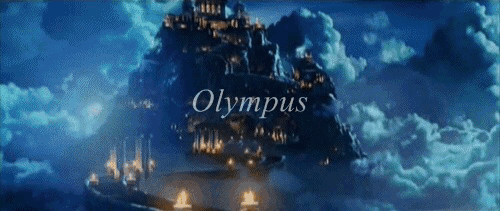
This deep dive is a payment to my friend Bri @briislame, May you look up and find Zeus looking down with smiles.
~I use resources, I do not own the info, and most deep dives have UPG (that I use in my work.) And I only take some information from sources. I am 14, this is my hobby, I am learning but I spent many hours and days on this, and I am always open to criticism. I have been doing worship for 5 years. Please know you can use the info, I do not sue, but I will take action if this work is used without permission and not put as a resource if used in any work. without permisson and not put as a resource if used in any work, for the public.
#the gods#hellenic devotion#hellenic polytheism#hellenic worship#doing the research for you#greek gods#greek mythology#ancient greek#zeus deity#zeus#zeus greek mythology#zeus god#zeus worship#Zeus deity#Deity zeus#hellenic polytheist#hellenic deities#hellenic gods#hellenic pagan#hellenic paganism#hellenic#hellenic polythiest#hellenism
70 notes
·
View notes
Text


ODI ET AMO PART III: EX DEO
An interlude in Old World Blues.

The Courier is brought to Big Mountain, the 'Big MT', against her will— and, against all odds, she does what she does best; she takes the cards she is dealt to spur mortality unto divinity.
Numb without the autonomy that comes with being wholly intact, she walks the graveyard of the Big MT. She follows the ghosts of Old World flags painted on the walls, Christine's tapes, and Elijah's sickness as she collects upgrades worth fighting for.
There is more than only the Think Tank to contend with here; an infection lurks in all it might infect, waiting for the opportunity that only Courier Six has managed to manifest.
Gods are seldom born; they have to be made.

Part I: Infect the Haruspex Part II: Tinderbox
⠀⠀⠀⠀
DEAD DOVE DO NOT EAT: Please ensure you read the tags for this fic. The actions and events depicted are not endorsed as morally correct or justified; such is the point.
#krok.png#krok.txt#Line: Odi et Amo#Fallout: New Vegas#FNV#Fallout#Fallout Fic#Old World Blues#OWB#OC: Quinn#Courier Six
82 notes
·
View notes
Text
March divination with Demeter

1. What message do you have for followers of the temple?
Queen of Cups Reversed
Light
It is time to set boundaries. You may be a very helpful, energetic, and vibrant person- you may be someone who gives much of themselves for work, family, friends, lovers; but it is time to invest in yourself. Demeter does not want us to neglect community or obligations, but to set time and have space for ourselves. Some of us may have co-dependent or unhealthy relationships (in many senses of the word “relationship”), and it is time to think of those and how/if they even serve us. Deo and the Gods want what is best for us, and we can seek their counsel when we need it, if communication with the Theoi can aid us in leaving unhealthy bonds and coping; then I implore you to seek that communication. It is time to take care of yourself, you will not become evil if you care for yourself and ask for space.
2. What advice do you have for followers who may be going through difficult times this month?
Queen of Pentacles Reversed
Strength
In addition to the previous card pull, many of our difficult times may be in relation to providing too much for others or having financial hardship. I feel as though Demeter is imploring us to sit back and look at how we spend our time; are we giving up healthy meals for time to scroll, are we putting our attention on a toxic person instead of our own happiness, why are we not balancing work, life, love, and religion? There are many reasons for these issues at hand, if you can- please sit down and find out what works best for you to find balance and time for YOU and the many facets of life. You are not alone in this, the Theoi are with you.
3. What signs or symbols should followers be looking out for this month?
Knave of Cups
Look out for fish symbolism, bodies of water, intuitive messages, and artwork that inspires you.
This does not mean everything we see is a sign, but to look out for notable aspects of these things. Use discretion.
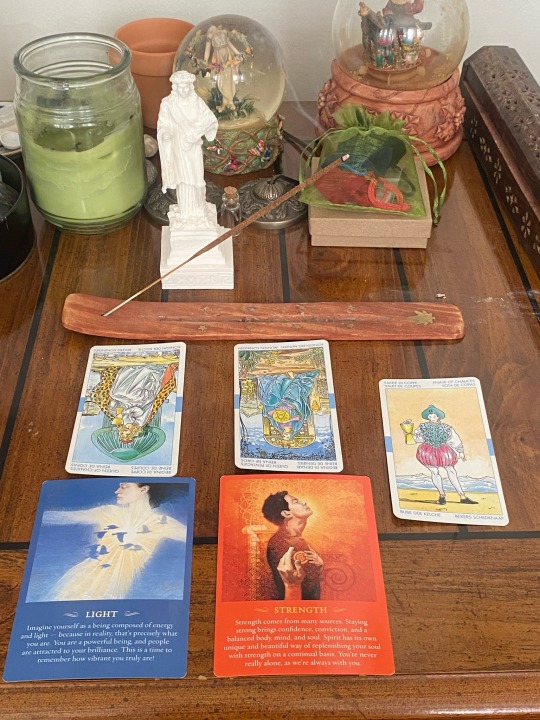
#demeter#hellenic polytheism#hellenic polythiest#hellenic pagan#hellenic deities#hellenic worship#temples post#monthly divination#divination#tarot#oracle cards#tarot cards
11 notes
·
View notes
Text
🌾DOSO🌾

🌾Doso🌾
"And she walked through the threshold and her head touchedThe roof, and she filled the doors with a divine radiance.And they were seized by reverence, awe, and pale fear."
An old rough sketch I made of Queenly Deo. She roamed around as a mortal while she mourned for her daughter.I pray she gives me strength to deal with my own losses, and I comfort myself knowing that spring will come again.
🌼🌾 May Demeter keep your plate full and your cup overflowing 🌾🌼
#demeter#demeter devotee#demeter devotion#hellenic polytheism#hellenic polythiest#greek mythology#helpol#art
70 notes
·
View notes
Text




“Mystics, Gnostics, Theosophists - all speak of a world of soul and spirit which for them is just as real as the world we see with our physical eyes and touch with our physical hands.” ― Rudolph Steiner
Apocalyptic Seal - 7 Resurrection. Talon Abraxas
Seventh Apocalyptic Seal
Finally, the seventh seal is that of the “Mystery of the Grail”, as it was native to the esoteric movement that began in the fourteenth century. On the picture there is a cube representing the space-world, from all sides of the cube springs the world-snake, in so far as it represents the higher forces acting out in the lower; from the mouth of the snake the world-line (as a spiral), the symbol of the purified and purified world-forces; and from this springs the “holy grail”, which is opposed by the “dove”: all this pointing - and quite appropriately - to the mystery of the creation of the world, of which the earthly is a lower reflection. The deepest mysteries lie in the lines and figures, etc., of this seal.“ (Lit.:GA 34, p. 599)
Seal VII is the reproduction of the “Mystery of the Holy Grail”. It is the astral experience which reflects the universal meaning of the development of humanity. The cube represents the “space world”, which is not yet permeated by any physical being or physical event. For spiritual science, space is not merely the “void”, but it is the carrier which, in a still invisible way, contains within itself the seeds of all that is physical. Out of it, as it were, the whole physical world precipitates, as a salt precipitates out of the still quite transparent solution. And what - in relation to the human being - develops out of the spatial world, undergoes the development from the lower to the higher. Out of the “three dimensions of space”, which are expressed in the cube, first grow the lower human forces, illustrated by the two serpents, which again give birth to the purified higher spiritual nature, which is represented in the world spirals. Through the upward growth of these higher forces, man can become the recipient (chalice) for the reception of the pure spiritual world-being, expressed by the dove. Through this, man becomes the master of the spiritual world powers, whose image is the rainbow. This is a very sketchy description of this seal, which contains immeasurable depths that can be revealed to those who allow it to work on them in devotional meditation. This seal is paraphrased with the truth saying of modern spiritual science: “Ex deo nascimur, in Christo morimur, per spiritum sanctum reviviscimus”, “Out of God I was born; in Christo I die; through the Holy Spirit I am born again”. In this saying the meaning of human development is fully indicated.“ (Lit.:GA 284, p. 94f)
We have seen in a certain way that in the beginning of the evolution of mankind and at the end of it there are the same states of transformation. We have seen these states represented in the man with the flaming feet and the sword protruding from his mouth. In a profound symbolism, the whole being of the world is now revealed to us in the symbol of the Holy Grail. With a few sketchy words I would like to place this seventh seal before your soul.
He who, as an occultist, comes to know our world, knows that space is something quite different for the physical world than mere emptiness. Space is the source from which all beings have, as it were, physically crystallised. Imagine a glass cube-shaped vessel, through which you can see completely, filled with water. And now imagine that certain cooling currents are conducted through this water, so that ice is formed in the most manifold ways. In this way you can get an idea of the creation of the world: the “space”; spoken into the space is the divine word of creation; crystallised out are all things and beings.
This space, into which the divine word of creation is spoken, is represented by the occultist through the water-light cube. Various beings develop within this space. Those closest to us can best be characterised as follows: the cube has three perpendicular directions, three axes, length, height, width - the three dimensions of space are represented by the cube. And now think of the counter-dimensions to these three dimensions as they are outside in the physical world. You can imagine it like this: one person is walking in one direction and another person is coming towards him and the two collide. In a similar way, there is a counter-dimension to each spatial dimension, so that we have six rays in total. These counter-rays represent at the same time the primordial germs of the highest members of the human being. The physical body, crystallised out of space, is the lowest. The spiritual, the highest, is the opposite; it is represented by the counter-dimensions. Here, in development, these counter-dimensions first form themselves into an entity which can best be represented by letting them flow together into the world of passions, desires, instincts. That is what it is at first. Then later it becomes something else. More and more it purifies itself - we have seen to what height - but it has gone out from the lower drives, which are symbolised by the serpent. This process is symbolised by the convergence of the counter-dimensions in two snakes facing each other.
By purifying itself, humanity ascends to what is called the “world spiral”. The purified body of the serpent, this world spiral, has a deep meaning. You can get an idea of it from the following example: Modern astronomy is based on two propositions of Copernicus; it has disregarded a third. He said that the sun also moves. The Sun moves forward, in a helical line, so that the Earth moves with the Sun in a complicated curve. The same is true of the moon, which moves around the earth. These movements are far more complicated than is assumed in elementary astronomy. You see here how the spiral has its meaning in the world bodies; and these world bodies represent a figure with which man will one day identify himself. In that time man’s power of production will be cleansed, purified; the larynx will then be the organ of procreation. That which man will have developed as a purified serpent’s body will then no longer work from below but from above. The transformed larynx in us will become the chalice called the Holy Grail. And just as the one will be purified, so will the other which connects itself with this producing organ: it will be an essence of the world-power, the great world-essence. And this world-spirit in its essence is represented by the image of the dove facing the Holy Grail. Here it is the symbol of the spiritualised fertilisation which will work out of the cosmos when man has one day identified himself with the cosmos. The whole creative aspect of this process is represented by the rainbow: this is the all-embracing seal of the Holy Grail.
The whole gives the sense of the connection between world and human being in a wonderful way, like a summary of the sense of the other seals. This is why the secret of the world is inscribed on the outer edge of the seal. This mystery of the world represents how man is born in the beginning out of the elemental forces of the world. Every human being, when he looks back, has gone through that process in the beginning of time which he is going through spiritually today when he is born anew out of the forces of consciousness. This is what Rosicrucianism expresses [with the letters] E. D. N. : Out of God I am born.
We have seen that within Revelation a second thing is added: death to life. But man, in order to find life again in this death, must overcome this death of the senses in the original source of all living things. And this primal source is the centre of all cosmic development; for we had to find death in order to attain our consciousness. But we shall overcome it when we find the meaning of this death in the Saviour-Mystery. Just as we are born of God, we die in Christo in the sense of esoteric wisdom: I. C. M.
And because wherever something is revealed, there is a duality to which the third must unite, man, when he has overcome death, will identify himself with the spirit (the dove) which pervades the world. He will resurrect and live again in the Spirit: P. S. S. R.
This is the Theosophical Rose Cross. It shines into those times when religion and science will be reconciled.“
(Lit.:GA 284, p. 77) Rudolf Steiner
36 notes
·
View notes